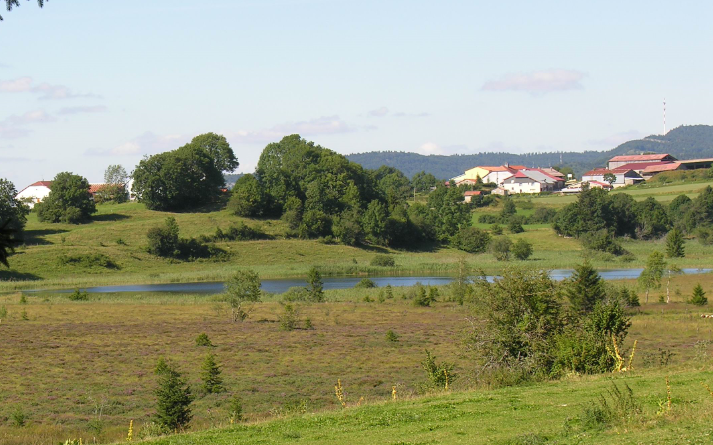
Rouges Truites lake discovery circuit
This short circuit will bring you as close as possible to the peat bog. By being quiet and alert, you might see several species of birds nesting here. You will also discover part of the heritage belonging to the Lac-des-Rouges-Truites municipality, and its inhabitants will be happy to tell you about its history.
11 points of interest
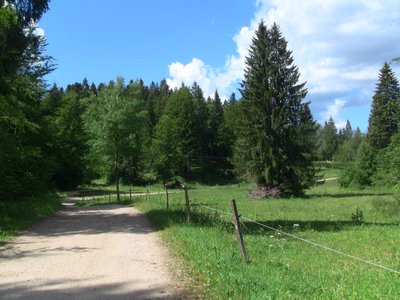
Epicéas en bordure de forêt - A.RULLIER FloraThe spruce
A widespread conifer in Europe, this tree is the ultimate tree of mountainous regions. Some high-quality wood can be used for lutherie to make soundboards for various instruments (violins, guitars, etc.). However, most of production is used for lumber (construction and woodwork).
It is often confused with fir. However, a keen eye will be able to notice a difference in the needles, which are pointed on the spruce and flat and rounded on the fir, or in the position of the cones (fir cones). The spruce’s cones direct downwards at the end of drooping branches, whilst the fir’s cones point upwards at the end of upright branches.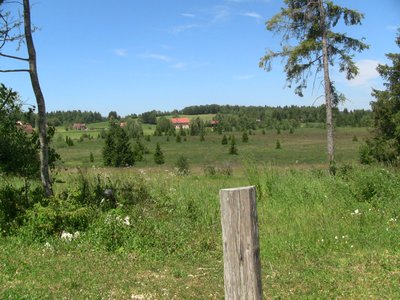
La tourbière du Lac-des-Rouges-Truites - A.RULLIER Natural environmentsThe peat bog
This fragile environment is quite exceptional. Formed as a result of vegetation that has badly decomposed due to a lack of oxygen, this water-logged soil offers a unique habitat to the species living here. Such species are well adapted to this environment and most could not survive elsewhere. The Lac-des-Rouges-Truites peat bog is home to many species. Examples are rare species such as sphagnum obtusum: a sphagnum, peat moss, which only exists in France in a peat bog in the Cantal and here; and the round-mouthed whorl snail, a very small snail that was once believe to be extinct in France, before being found only here in 2014.
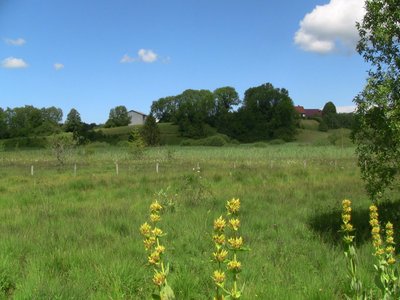
Gentiane jaune et tourbière - A.RULLIER Natural environmentsThe exploitation of peat bogs
The lack of oxygen in a peat bog prevents dead plants from decomposing. This results in an accumulation of organic matter, creating a sort of spongy earth that is referred to as peat moss. This peat moss was once extracted in bricks and dried during good weather. It was used as fuel, in wood burners when wood was sparse in the Jura. This exploitation continued for many centuries. Deep trenches are still visible in the Jura peat bogs, ensuring that the peat that has not been exploited dries out.
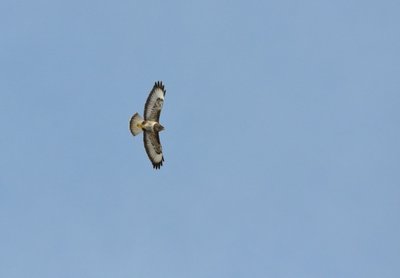
Buse variable en vol - F.CROSET FaunaThe common buzzard
Among the birds of prey on the Mont-Noir, the common buzzard is probably the easiest to spot. Its habitat is very varied. They build their nests in trees, often in the woods, and
They use meadows and marshes as hunting grounds. Its diet is mainly comprised of small mammals, but also of reptiles, amphibians and insects. When hunting, it must first locate its prey: either by circling overhead - up to 100 metres above ground - or by perching in wait for long periods of time.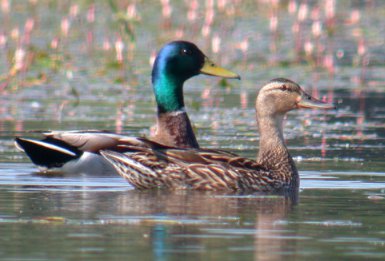
Couple de Canard colvert - F.CROSET FaunaThe mallard
Although well known, the mallard is good at being discreet and hiding between the reeds when necessary. This bird has an excellent ability to adapt and is a specialist in quickly taking flight if it feels threatened. It can even reach speeds of up to 80km/h!
Found in all types of humid environments, it favours reedbeds as they provide vital shelter to the mallard and its family. It generally feeds on seeds and plants, but it sometimes hunts small invertebrate molluscs on the water surface. It is worth noting that males and females have different plumage.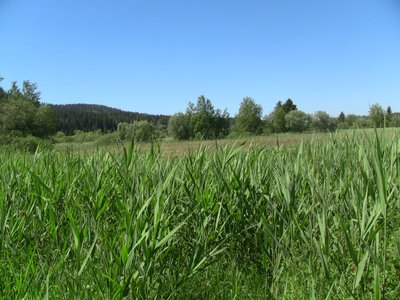
Roselière - A.RULLIER FloraThe reedbed
Mainly comprised of high vegetation, dominated by reeds - hence the name - it provides shelter to many birds and insects such as ducks and fireflies. Dead reeds are often the main components when the Jura peat bogs form. It is a very hardy plant, with deep roots which easily acclimate to these marshes.
Under certain conditions, reeds can become “invasive”, and spread in the peat bog, “suffocating” the other lower plants. Climate change and air pollution seem to encourage this.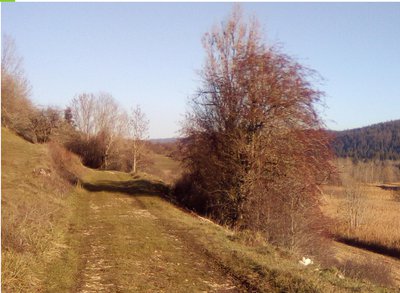
Voie du tram Laure Gobin/OT Haut-Jura Grandvaux - Laure Gobin OT Grandvaux History & HeritageThe Tram Line
The tram line you are on was opened in 1907. It passed through Lac des Rouges Truites and linked Clairvaux-les-Lacs to Foncine-le-Haut and served Saint-Laurent-en-Grandvaux.
Like all Jura tram lines, due to lack of profit and competition from the development of bus services and automobiles, it closed in 1938.
Will you be able to find the old station in the hamlet of Thévenins on returning to Bugnon?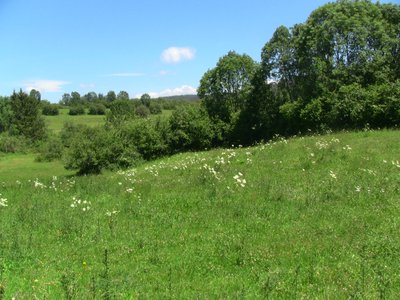
A.RULLIER Natural environmentsWet meadow
Here, the peripheries of peat bogs are still grazed on. These wet meadows, which are characterised by the presence of a large amount of water in the soil, are also very rich for biodiversity. Some flowers, such as the bird’s-eye primrose, particularly flourish here.
These are also areas of transition between the rest of the valley and the peat bog, and between the lake and the river. They filter water through the soil, eliminating nitrate, which limits the pollution of groundwater. Their presence is therefore vital to properly maintain a peat bog.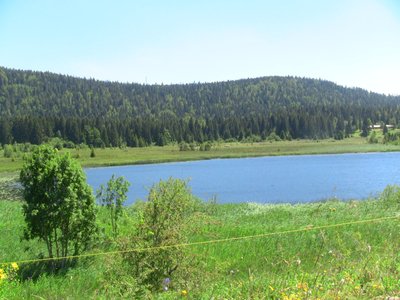
Le lac du Lac-des-Rouges-Truites - A.RULLIER History & HeritageThe mystery of Les Rouges Truites
The High-Jura is a land of many legends that likes to keep its secrets.
Rumour has resulted in four different version relating the origin of the name Lac des Rouges Truites:- Poetic: every evening, when the sun sets, trout take on a crimson hue due to the rays’ reflection on the lake.
- Practical: the trout are salmon trout.
- Physical: the water is said to contain iron oxide.
- Military: the lake is said to have been the site of a bloody battle.
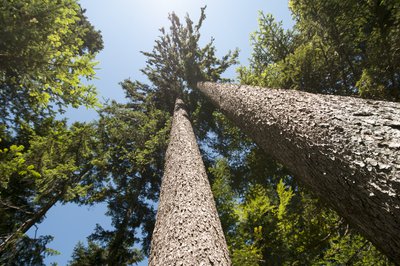
épicéas - PNRHJ / B. BECKER FloraMont Noir forest
Spread across 1873 hectares, the Mont Noir massif is one of the largest Jura forests. It is currently made up of dark-leaved trees, such as fir, spruce and beechwood, hence its name. Stags, boar and roe deer live here alongside the lynx and the western capercaillie. Wood exploitation is an important economic activity for our mountains. However, the forest also accommodates hikers wishing to take long works on the waymarked paths, both during summer and winter. Share this area and be careful if you come across forest works.
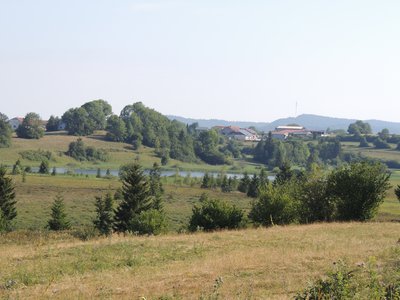
Lac des Rouges Truites - PNRHJ - F. Jeanparis Natural environmentsView over the lac des Rouges Truites peat bog
Inherited from the icebergs which covered the Jura ten thousand years ago and left behind moraines with water-tight bottoms, a peat bog formed from the accumulation of stagnant water full of cold-resistant plants. The moving soil in peat bogs are made up of a thick carpet of peat moss, on which a few well-adjusted plants are able to grow (cranberry, cottongrass, andromeda, drosera, mountain pine, etc.) These fragile environments are of biological interest and must therefore be preserved.
Description
From the Le Bugnon chalet behind you, follow the white path to the right. This path alternates between woods and meadows. Carry on straight until you come to round metal bars in the ground: this is a cattle grid (vehicles can pass through, but cattle cannot. This means the cows are well kept!) Before crossing, take a quick trip on the grassy path to your right to a small cabin (built after the 1999 storm, this small structure was used to house a pump which watered the woods and avoided them becoming damaged). Take the time to admire the peat around you before returning the way you came and continuing left on the white path. Further along, on exiting the forest, you will come to a large meadow at the Rquai bridge (Pont du Rquai). Take care when heading along the barbed wire to your left, you will discover a small opening to enter the field. Follow the grassy path that is still visible and head along the white stone. You will come to the entrance to another field, which may be obstructed depending on the season by an electrical wire, take care to put the wire back in place if necessary. Continue towards the small wooden bridge over the river. Continue straight, heading up the chariot path lined with trees. When you reach another path, at Voie du tram, head left and admire the landscape while you walk. You have a birds-eye view over the entire humid area. Continue on this landscape path and it will bring you to the hamlet of Thévenins (the old cheese dairy to your right was created in 1905. Since 2017, the cooperative of the Lac-des-Rouges-Truites merged with the Saint-Pierre cooperative, becoming the Pays Grandvallier cooperative. Their combined milk - 97% of which is used to make Comté - is transformed in a new cheese dairy building in Saint-Laurent-en-Grandvaux.) When you reach the first houses, take the small road to the left that heads between a few houses. From the Station (La Gare), the old tram station, head down the road that crosses the valley towards the Domaine du Bugnon. Take care when heading along the barbed wire to your left, you will discover a small opening to enter the field. Follow the grassy path that is still visible and head along the white stone. You will come to the entrance to another field, which may be obstructed depending on the season by an electrical wire, take care to put the wire back in place if necessary. Continue towards the small wooden bridge over the river. Continue straight, heading up the chariot path lined with trees. When you reach another path, at
- Departure : Le Bugnon
- Arrival : Le Bugnon
- Towns crossed : Lac-Des-Rouges-Truites
Forecast
Sensitive areas
- Impacted practices:
- Aquatic,
- Sensitivity periods:
- JanFebMarAprMayJunJulAugSepOctNovDec
- Contact:
- Parc naturel régional du Haut-Jura
29 Le Village
39310 Lajoux
03 84 34 12 30
www.parc-haut-jura.fr/
- Impacted practices:
- Aquatic,
- Sensitivity periods:
- JanFebMarAprMayJunJulAugSepOctNovDec
- Contact:
- DREAL Bourgogne-Franche-Comté
Cité administrative VIOTTE
5 voie Gisèle Halimi - BP 31269
25005 BESANÇON CEDEX
Tél : 03 39 59 62 00
Recommandations
This trail passes through pastures with livestock. For the security of livestock and wild fauna, we ask that you remain on the waymarked paths.
Use the adapted passageways to get across fencing and be sure to close gateways behind you.
Please keep your dog on a lead if you have one.
Wild flowers are beautiful, they may be rare and protected and often wilt quickly. Do not pick them! They will delight the next hikers.
Information desks
Tourist information centre - Haut-Jura Grandvaux
7 place Simone Veil, 39150 Saint-Laurent-en-Grandvaux
Transport
To visit and get about in the High-Jura, visit www.reshaut-jura.fr, the eco-mobility portal listing all means of transport within the Park.
Access and parking
6 km from Saint-Laurent-en-Grandvaux via the D 437 until Thévenins, then 200 m after the church, turn right on the road that leads to the Domaine du Bugnon.
Parking :
Report a problem or an error
If you have found an error on this page or if you have noticed any problems during your hike, please report them to us here:
